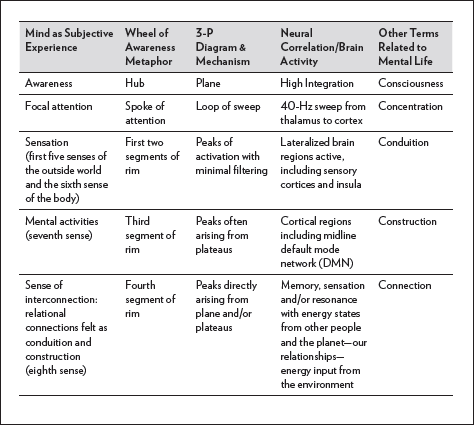Aware: The Science and Practice of Presence
Watch Dr. Dan Siegel introduce his new book, Aware, an exploration of a groundbreaking meditation practice and the mind:
“Travel Guide to the Mind”
In the book, Aware: The Science and Practice of Presence, you will learn a practical way to create well-being in your life. Based on the science of meditation, this “travel guide to the mind” will offer you in Part I step-by-step instructions on how to practice the Wheel of Awareness. The Wheel is a simple way of imaging the knowing of consciousness within the hub of this visual image of a wheel and the knowns, such as what you see or hear, what you think or feel, on the wheel’s rim. As you differentiate these various “rim-elements” of knowns from each other and then link them with the Wheel’s sole spoke of attention to the hub, you’ll be integrating consciousness itself. Integration—the linking of differentiated parts of something—is the basis for well-being. As you integrate consciousness as a state of clarity in your life with practice, you’ll be creating a change in your baseline way of being. This is how an intentionally created state becomes a long-term trait in your life.
The traits of integration include being flexible and adaptive, coherent and resilient, energized and stable. This way of being is sometimes called eudaimonia, the kind of happiness that comes along with a sense of equanimity, connection, and meaning.
The science of mind-training that involves the Wheel’s three components of focused attention, open awareness, and kind intention form the foundation for how Aware in Part II then takes you on a journey into the mechanisms of mind beneath the metaphor of the Wheel. You’ll explore the brain science underlying the experience of consciousness, and you’ll discover how integration in the brain seems to be the basis for being aware. But what is awareness itself? To dive deeper into this foundational question, we’ll then explore the proposal that mind—including its four facets of subjective experience, consciousness, information processing, and self-organization—actually may be an emergent property arising from energy flow. Energy is studied by physics; systems studied by mathematics. When we see that the system of energy and information flow is not limited by your skull-encased brain or your skin-encased body, then the notion that the mind emerges from energy flow and turns back and regulates it—it organizes “itself”—helps us see how the mind is both “within” us and “between” us. This inner and inter mind can be felt directly within the Wheel of Awareness practice.
The study of energy reveals how it can be viewed as “the movement from possibility to actuality”—a strange sounding notion at first, but one we’ll explore in great depth with practical applications and profound implications. After offering the Wheel practice systematically to over ten thousand people and recording the experiences of many of those who described the Wheel’s various segments, we’ll see that this view of energy actually maps well onto the ways in which subjective experience—like the feeling of an emotion, thought or memory—seems to “bubble up” from some pool of something. That source of our mental life may be consistent with a “plane of possibility,” a location on a diagram you’ll see in the book that locates mental activities up at a peak of 100 percent probability, states of mind and moods at a plateau of elevated probability, and this plane of possiblity at the lowest level of probability as a proposed source of being aware. Low probability means high potentiality, and this plane of possibility then may correspond to the origin of consciousness as described by many who, in the Wheel practice, bend the spoke of attention around into the hub of knowing and describe the following common experiences: openness, joy, eternity, infinity, god, love, and awe. This state of pure awareness, this proposed origin of consciousness, may be when the probability position of energy has moved into the plane—what may be the source of knowing as well as the source of new options, new choices. The plane of possibility corresponds to what physicists describe as a sea of potential or the quantum vacuum, a mathematical space where potentials rest before they arise into actualities. In other words, the plane of possibility may be both the mechanism of being aware and the formless origin of all potential forms. This may also be why so many doing the Wheel practice describe the quality of pure awareness being so full yet simultaneously so empty.
So much exciting vistas into the nature of consciousness we’ll dive more deeply into on our journey together with the Wheel of Awareness.
In part III we’ll explore how five individuals we met in Part I have experienced the Wheel as an idea and practice, seeing in more detail with this new Plane of Possibility framework how it has been used in their lives to create more well-being in their inner and relational worlds. In Part IV, we summarize where we’ve come, integrating these new insights into the mind and being aware, reflecting on how you can use the Wheel in your own life to create a life of meaning, connection, and equanimity on your journey ahead.
The following table, placed in the book after Part II’s in-depth discussion of mechanisms of mind, offers you a sneak-peak at some of the conceptual foundations that will become second nature to you on your journey through the practice and ideas of Aware. While seeing this table now, before reading the book, may feel a bit confusing, perhaps even overwhelming with all the new terms, it may peak your interest and make you curious about how this all fits with your own inner life. While these ideas may be new, reading the book will help them become a natural part of how you sense and experience your own inner and relational life and bring more balance into your world. My hope is that this table, and the book itself, will invite you to explore this framework of science and subjective experience and see how useful they can be in creating more well-being in your life. I hope you’ll enjoy the immersion and conceptual framework and look forward to hearing from you about how this exciting journey goes for you!

Watch Dan go through the Wheel of Awareness practice:








Leave a Reply